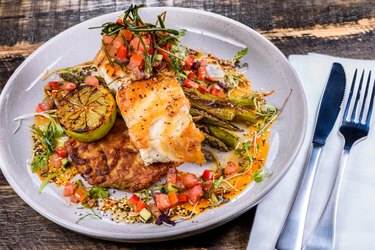
If you want to add more lean protein to your plate, look no further than fish. While salmon often steals the spotlight, there's literally an ocean of other fish options that serve up this muscle-building macro, along with additional vitamins and minerals.
Getting more of your protein from seafood is also a smart health strategy. "In developed countries, replacing meat from land animals with other sources of protein, including fish, could reduce the burden of diet-related chronic diseases," says Ryan Andrews, RD, principal nutritionist and adviser for Precision Nutrition.
Video of the Day
Video of the Day
For the best catch of protein, start with these 12 sustainably sourced swimmers that will give you 19 grams or more per serving.
1. Yellowfin Tuna
In a 3-ounce serving of cooked yellowfin tuna, you'll get:
- 111 calories
- 25 grams of protein
Yellowfin tuna touts an ample amount of iron, Andrews says. That means you can trade tuna for beef and still get enough of this essential mineral, which is involved in transporting oxygen around the body.
"Look for yellowfin tuna that's wild-caught in the Atlantic or Pacific Oceans with pole-and-lines and trolling lines. This leads to less bycatch, or catching unintended wildlife and harming surrounding ecosystems. If possible, avoid all farmed tuna," he says.
In addition, "Don't eat more than six ounces of yellowfin tuna each week, as they are susceptible to mercury contamination and aren't always sustainably caught," Andrews says. "And I advise avoiding all bluefin tuna, as there are no sustainable sources."
2. Coho Salmon
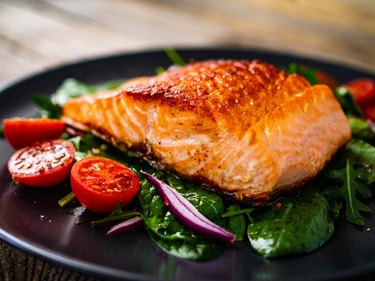
In a 3-ounce serving of cooked coho salmon, you'll get:
- 156 calories
- 23 grams of protein
Salmon are swimming in nutrients including vitamin B12, selenium, vitamin D, vitamin B3 and omega-3 fats, Andrews says. Plus, there are so many different ways to cook salmon.
But keep in mind: "Most salmon are farmed, and sourcing can be tricky," Andrews says. "Aim for salmon that has been certified by the Marine Stewardship Council or Aquaculture Stewardship Council."
Try this Cajun Salmon and Fruit Salsa recipe from Precision Nutrition.
3. Tilapia
Per 3-ounce serving of cooked tilapia, you'll get:
- 109 calories
- 22.5 grams of protein
Tilapia is a treasure trove of vitamin D, vitamin B12, potassium and magnesium, Andrews says. Mild-flavored, tilapia doesn't taste "too fishy" and is affordable, which explains why it's so popular.
When shopping for these fantastic fish, "look for tilapia farmed in Peru or Ecuador and avoid tilapia farmed from China," Andrews says.
There's some evidence that farmed tilapia are fed manure from livestock, which can increase the risk of bacterial contamination and, consequently, the need to treat the fish with antibiotics, according to McGill's Office for Science and Society.
Try this Tilapia Tacos with Avocado Sauce recipe from Precision Nutrition.
4. Snapper
Per 3-ounce serving of cooked snapper, you'll get:
- 109 calories
- 22 grams of protein
A prominent metallic pink in color, snapper is a snazzy-looking fish with a font of vitamin B12, Andrews says.
"Snapper from the U.S. tends to be a better option, but avoid any red snapper from the Atlantic Ocean and lane snapper from the Gulf of Mexico," Andrews says.
And because snapper tends to have moderate amounts of mercury, stick to one serving each week, he adds.
Try this Red Snapper With Roasted Almond Chimichurri recipe from Precision Nutrition.
5. Grouper
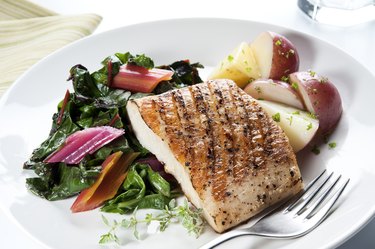
Per 3-ounce serving of cooked grouper, you'll get:
- 100 calories
- 21 grams of protein
Grouper is a great source of vitamin B12, supplying 24 percent of the recommended daily value (DV). This essential B vitamin is vital for making DNA and producing energy in our cells, per the USDA.
Limit yourself to one serving of grouper per week (due to the possibility of mercury contamination) and avoid scamp, snowy and Warsaw grouper, as well as black and red grouper from Mexico, Andrews says.
6. Northern Pike
Per 3-ounce serving of cooked northern pike, you'll get:
- 96 calories
- 21 grams of protein
Northern pike is a powerhouse of B vitamins (including niacin, B5 and B12) and selenium (25 percent of your DV). A trace mineral, selenium plays important roles in cell protection, thyroid gland function, DNA synthesis, and immune and reproductive function, per the USDA.
When shopping, "look for pike from Canada that's been certified by the Marine Stewardship Council," Andrews says.
7. Canned Sardines
Per 3-ounce serving of canned sardines, you'll get:
- 177 calories
- 21 grams of protein
Start stocking up on canned sardines. These tiny fish flaunt some big benefits for your heart and bones, just to name a few. That's because canned sardines are stacked with essential nutrients including vitamin B12, selenium, omega-3 fats, vitamin D, calcium, vitamin B3, vitamin B2 and choline, Andrews says.
"When selecting sardines at the supermarket, if possible, opt for Pacific sardines certified by the Marine Stewardship Council," Andrews says.
Try this Sardine and Sun-dried Tomato Spaghetti recipe from Precision Nutrition.
8. Mahimahi
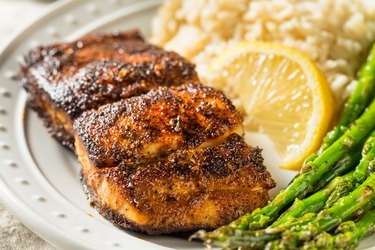
Per 3-ounce serving of cooked mahimahi, you'll get:
- 93 calories
- 20 grams of protein
Mahimahi is a sweet-tasting, tropical, flaky fish with a font of selenium (72 percent of your DV) and niacin (39 percent of your DV). An essential B vitamin, niacin is needed to process fat in the body, lower cholesterol levels and regulate blood sugar levels, per the USDA.
"Look for mahimahi from the North Atlantic in the U.S. caught with handlines and hand-operated pole-and-lines (as other fishing methods can lead to bycatch)," Andrews says.
And to minimize your mercury exposure, make mahimahi only once a week, he adds.
9. Smoked Whitefish
Per 3-ounce serving of smoked whitefish, you'll get:
- 92 calories
- 20 grams of protein
Whitefish is a windfall of vitamins including vitamin B12 (115 percent of your DV) and vitamin D (54 percent of your DV).
And this is especially important: Approximately 42 percent of Americans are lacking in vitamin D, which your body requires to maintain strong bones and healthy immune function, according to Cleveland Clinic Mercy Hospital.
Try choosing whitefish that are caught in the U.S./Canadian Great Lakes (except for Wisconsin's Lake Superior's waters and Canada's Lakes Winnipeg and Winnipegosis), Andrews says.
10. Atlantic Mackerel
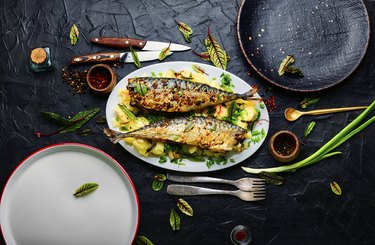
Per 3-ounce serving of cooked Atlantic mackerel, you'll get:
- 223 calories
- 20 grams of protein
If you're keen to incorporate more high-protein fish into your diet, consider adding mackerel to your menu.
"Look for Atka mackerel from Alaska or Atlantic Spanish mackerel caught with cast nets," Andrews says. Both varieties are high in omega-3s (which help fight inflammation) and low in mercury, according to the Cleveland Clinic.
But not all mackerel are good for you. "Avoid king mackerel due to mercury contamination," Andrews says.
11. Trout
Per 3-ounce serving of cooked trout, you'll get:
- 128 calories
- 20 grams of protein
A relatively mild-flavored fish, trout is a terrific canvas for cooking. It also supplies a solid amount of potassium, Andrews says. This mighty mineral helps your body maintain fluid and electrolyte balance and is involved with the transmission of electrical impulses in the heart, per the USDA.
Trout from Lake Superior's Minnesota waters is a wonderful option, but farmed trout – that's raised with indoor recirculating tanks – is also a good choice, Andrews says.
12. Atlantic Cod
Per 3-ounce serving of cooked Atlantic cod, you'll get:
- 89 calories
- 19 grams of protein
Like other foods found in the sea, Atlantic cod is naturally rich in iodine, Andrews says. Your body needs iodine to produce thyroid hormones, which control growth and metabolism, per the USDA.
But finding a sustainable source of Atlantic cod can be difficult. "Most Atlantic cod is caught using fishing gear that harms surrounding ecosystems," Andrews says. To avoid this, only choose Atlantic cod if it's from the U.S. Georges Bank or U.S. Gulf of Maine and caught with hand-operated pole-and-lines.
Alternatively, Pacific cod from Alaska is a good choice too, Andrews adds.
Try this Poached Cod In Coconut Lemongrass Broth recipe from Precision Nutrition.
- McGill's Office for Science and Society: "Tilapia and the “Poop Connection”"
- USDA My Food Data: “Top 10 Foods Highest in Vitamin B12 (Cobalamin)”
- USDA My Food Data: “Top 10 Foods Highest in Selenium”
- USDA My Food Data: “Top 10 Foods Highest in Vitamin B3 (Niacin)”
- USDA My Food Data: “Foods High in Iodine”
- USDA My Food Data: “Top 10 Foods Highest in Potassium”
- Cleveland Clinic Mercy Hospital: “42% Percent of Americans Are Vitamin D Deficient. Are You Among Them?”
- Cleveland Clinic: “3 Healthiest (and Worst) Fish For Your Health”
- "The New York Times"; High Mercury Levels Are Found in Tuna Sushi; Marian Burros; January 2008